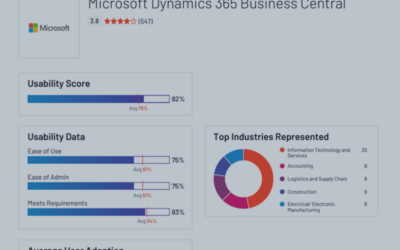Enterprise resource planning software (ERP) is one of the most exciting business technologies out there these days. More and more businesses, from manufacturing to retail, are exploring their options. If you are in the market for a new ERP solution at your business, what are your choices exactly? There are several types of ERP systems available today, each with their own range of benefits.
Let’s look at each.
ERP by Tier
One way in which experts categorize ERP software is by what the system includes. The products in each of the four tiers offer benefits for a specific type of business.
Tier I ERP:
Tier I ERP systems are designed for large-scale, global enterprises that operate across multiple countries and require robust features and capabilities. These systems offer comprehensive solutions that encompass various departments and processes within the organization. They typically provide support for multiple currencies and languages, making them suitable for international companies.
Examples of Tier I ERP software include:
- SAP S/4HANA: SAP S/4HANA is an enterprise resource planning software suite that integrates various modules for finance, supply chain management, human resources, sales, and more. It offers extensive functionalities suitable for large global enterprises.
- Oracle ERP Cloud: Oracle ERP Cloud provides a wide range of modules to manage financials, procurement, projects, supply chain, and human capital. It offers comprehensive features for large organizations with global operations.
Tier II ERP:
Tier II enterprise resource planning systems target companies that may have branches in multiple countries but do not require the extensive capabilities provided by Tier I solutions. These systems offer a balance between functionality and complexity. They provide essential features needed for multi-location operations without the additional complexities of international support.
Examples of Tier II ERP software include:
- Acumatica Cloud ERP: Acumatica Cloud ERP provides comprehensive functionalities for companies with multiple locations or subsidiaries but without the need for extensive international capabilities. It offers modules for finance, distribution, manufacturing, project management, and customer relationship management (CRM).
- Microsoft Dynamics 365: Microsoft Dynamics 365 is a suite of business applications that includes ERP modules such as finance, supply chain management, sales, and customer service. It caters to organizations with multiple locations and offers a scalable solution.
- Infor CloudSuite: Infor CloudSuite provides industry-specific ERP solutions for sectors like manufacturing, distribution, and retail. It offers features suitable for companies with regional or national operations.
Tier III ERP:
Tier III ERP systems are designed for mid-sized businesses that require basic language and currency support but do not need extensive international capabilities. These solutions offer essential functionalities for managing various business processes.
Examples of Tier III ERP software include:
- NetSuite: NetSuite is a cloud-based ERP system that integrates modules for finance, inventory management, order management, and CRM. It caters to mid-sized businesses and provides basic international support.
- Epicor ERP: Epicor ERP offers comprehensive modules for finance, manufacturing, supply chain management, and distribution. It is suitable for mid-sized organizations operating in specific industries.
Tier IV ERP:
Tier IV ERP solutions are tailored for small businesses (SMBs) that want to use the software to handle core business functions but may not need advanced features like extensive inventory management or supply chain capabilities. These solutions are often cloud-based and offer ease of integration into existing SMB workflows.
Examples of Tier IV ERP software include:
- QuickBooks Enterprise: QuickBooks Enterprise is an accounting and financial management software that offers additional modules for inventory management, sales, and purchasing. It is designed for SMBs and provides basic ERP functionalities.
- Zoho One: Zoho One is a suite of cloud-based business applications that includes modules for finance, human resources, sales, and marketing. It caters to SMBs and provides essential ERP features in an integrated platform.
ERP By Deployment Model
There are three common options for deploying enterprise resource planning (ERP) systems: cloud, hybrid, and on-premises. Each option offers distinct benefits and considerations. Let’s explore them further.
Cloud ERP
Cloud-based ERP solutions have gained popularity, particularly among small and medium-sized businesses (SMBs). With a cloud ERP, the software and data are managed by a third-party vendor, reducing the need for extensive IT infrastructure and dedicated servers within the organization.
Cloud ERP offers several advantages:
- Low Maintenance: Cloud ERP eliminates the need for complex IT setups. The vendor handles software updates, security, backups, and server maintenance, reducing the IT burden.
- Scalability: Cloud ERP allows businesses to easily scale their system as their needs grow, adjusting user numbers, storage capacity, and functionality without significant upfront investments.
- Accessibility: Cloud-based ERPs enable remote access, facilitating collaboration and productivity from anywhere with an internet connection.
Hybrid ERP
Hybrid ERP combines cloud-based components with an on-premises ERP system, catering to businesses with specific functionality needs or strict regulatory requirements.
Key benefits include:
- Data Security: Industries like healthcare and finance have strict data security regulations. Hybrid ERP allows storing sensitive data on-premises while leveraging the cloud for less sensitive operations.
- Customization and Integration: Hybrid ERP offers flexibility in integrating on-premises systems with cloud-based applications, allowing customization and integration with legacy systems.
- Cost Optimization: Hybrid ERP optimizes costs by using cloud services for non-critical operations while maintaining on-premises systems for core functions.
On-Premises ERP
On-premises ERP refers to the traditional deployment approach where the software and infrastructure are implemented and managed within the organization’s premises. This option provides control and customization but requires a robust IT infrastructure and skilled IT staff.
Advantages of on-premises ERP include:
- Control and Customization: On-premises ERP offers complete control over software, data, and infrastructure, allowing extensive customization.
- Data Control and Compliance: Organizations preferring on-premises ERP maintain direct control over sensitive data, ensuring compliance with regulations and security standards.
- IT Expertise: Implementing and managing an on-premises ERP system requires a skilled IT team capable of handling infrastructure setup, maintenance, updates, and security.
Not One Size Fits All
Organizations may also opt for a mix of deployment options based on their needs and priorities.
ERP by Industry
In addition to the categorization based on tiers and deployment options, enterprise resource planning (ERP) systems also vary based on industry-specific customization. ERP vendors have tailored their solutions to meet the unique needs of particular industries.
For instance, an ERP system designed for an industrial manufacturer will have distinct features and functionalities compared to one tailored for a retail enterprise. This industry-specific customization ensures that the ERP system aligns with the specific requirements and processes of the targeted niche.
When selecting an ERP system, it’s essential to consider the available modules that come with each type. The modules represent different functional areas that the ERP system covers. Depending on the system you choose, you can have a variety of modules available within your ERP solution. Some common modules found in ERP systems include:
- Accounting: This module manages financial transactions, general ledger, accounts payable and receivable, budgeting, and financial reporting.
- Order Processing & Tracking: This module handles the entire order lifecycle, from order entry to order fulfillment and shipment tracking, ensuring efficient order management.
- Logistics: The logistics module focuses on managing transportation, inventory management, warehousing, and distribution processes, optimizing the supply chain.
- Manufacturing: This module supports production planning, shop floor control, bill of materials (BOM), and overall manufacturing process management to enhance productivity and efficiency.
- Quality Control: The quality control module enables organizations to implement quality standards, perform inspections, track defects, and ensure compliance with regulatory requirements.
- Supply Chain Management: This module encompasses the end-to-end management of the supply chain, including procurement, demand forecasting, supplier management, and inventory optimization.
- Project Management: The project management module assists in planning, executing, and monitoring projects, including resource allocation, task management, and project collaboration.
- Budgeting and Forecasting: This module helps organizations in creating and managing budgets, financial forecasting, variance analysis, and financial planning.
- Human Resources: The human resources module covers employee management, payroll, benefits administration, talent acquisition, performance management, and training.
No matter which types you choose, ERP is a transformative technology that can streamline processes, ramp up productivity, and grow your business. With the different types of ERP systems out there, you have a lot of options to consider. Look at our ERP buying resources to learn even more about how to choose the right ERP for you. And let us know in the comments below about your journey!




